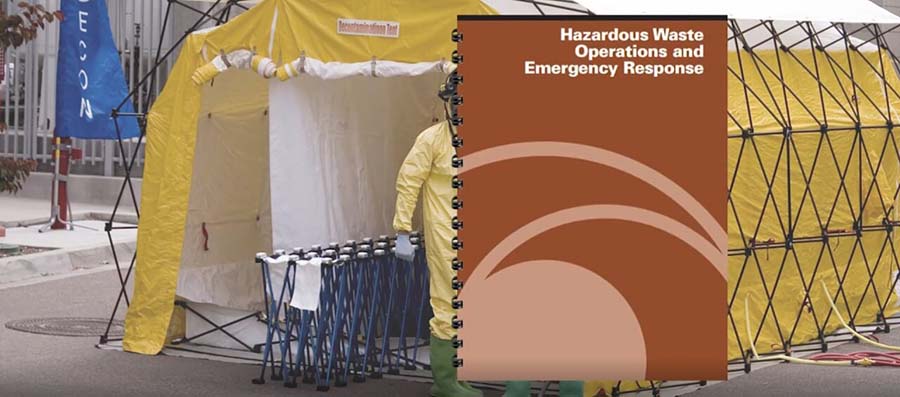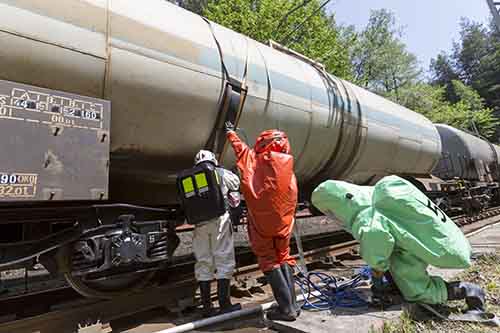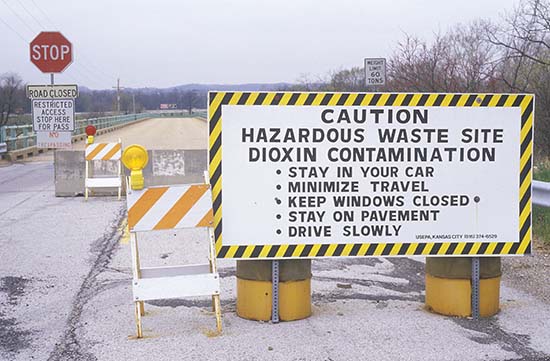The Hazardous Waste Operations and Emergency Response Standard, or HAZWOPER, was enacted by OSHA in 1990. It is designed to protect workers involved in the initial stages of a chemical release emergency, the subsequent clean-up of a site once the emergency has been stabilized, and the clean-up of chemical contamination from the country’s past industrial legacy. It is a comprehensive standard with origins which date back to the atomic bomb development sites of World War Two. Industrial incidents such as Love Canal, the Valley of the Drums, and the deadly chemical leak from the Union Carbide plant in Bhopal, India led to the development of specific waste management and community response legislation. OSHA saw the need to provide protection specifically for workers and developed HAZWOPER based on existing Department of Defense (DoD) guidance, with further input from the Environmental Protection Agency (EPA), the National Institute for Occupational Safety and Health (NIOSH) and the U.S. Coast Guard. It is a health and safety standard designed to train workers to be safe while they perform chemical response actions; it is not designed to train on specific technical response activities such as plugging chemical leaks or spill remediation.
Who needs HAZWOPER training?
The key word when applying HAZWOPER training is “uncontrolled”. When a chemical emergency occurs, or a site with a potential chemical legacy is discovered, these may be identified as uncontrolled sites by a government body if the “accumulation of hazardous substances creates a threat to the health and safety of individuals or the environment or both.” The level of government is irrelevant – it may be Federal, State or local – but the identification is made by the established relevant authority.
HAZWOPER is designed to reduce the risks of chemical exposure to workers employed in one of three very specific activities:
- Uncontrolled hazardous waste site operators
- Treatment, storage and disposal facility (TSDF) personnel
- Emergency responders
Uncontrolled waste site operators are those personnel who must enter a site of chemical contamination to perform clean-up and remediation duties. Often, the chemical contaminant identity and concentration will be unknown initially. These workers are provided protection by paragraphs (b) through (o) of the standard.
TSDF personnel are those workers employed at a controlled waste facility, but who will receive waste from uncontrolled sites for treatment. These workers are afforded protections under paragraph (p) of the standard.
Emergency responders are subject to different training requirements from waste site operators and TSDF personnel, as they must be able to respond quickly to stabilize an emergency situation. Requirements are outlined in paragraph (q) of the standard. Once a chemical situation is stabilized, then post-response operations are covered by paragraphs (b) through (o) as, following stabilization, this is now an uncontrolled waste site.
In general terms, HAZWOPER training is needed if workers are to be:
- Exposed to high concentrations of poisonous substances
- Exposed to chemical conditions that pose a fire or explosion hazard
- Entering sites with atmospheres at or above IDLH levels
- Exposed to oxygen deficient atmospheres (less than 19.5% oxygen)
- Leading evacuations due to chemical atmospheres or oxygen deficient conditions
- Performing confined space entry
- Supervising workers exposed to any of the above dangers
Who doesn’t need HAZWOPER training?
This may seem like an odd question, but we see the following scenario all the time: An organization has employees in roles that bring them into potential contact with hazardous chemicals and wastes, and they are assigned HAZWOPER training. Many do not need it. Workers whose duties are on controlled hazardous waste sites, such as landfills or waste collection facilities with non-permitted accumulator status under the Resource Conservation and Recovery Act (RCRA), often do not need HAZWOPER. Workers who handle chemicals for a living such as laboratory personnel, water treatment plant workers, or chemical manufacturing plant workers do not necessarily need HAZWOPER training either. Unless the worker is performing in one of the three uncontrolled hazardous waste site roles, or is supervising personnel in those roles, then HAZWOPER is not needed. In the majority of cases, these workers require a detailed and comprehensive training program under the Hazard Communication standard (HAZCOM). It is a problem we see often: HAZCOM is ineffectively applied and the gap is filled with HAZWOPER. This is inadequate and unproductive.
How do we train HAZWOPER?
Traditionally, HAZWOPER has been taught through conventional, instructor-led programs, and this is still a common delivery method. With the increasing popularity, and technical improvements, of online safety training, however, HAZWOPER training is becoming more accessible to a wider audience. It also provides a greater degree of flexibility in delivering key learning and technical objectives.
In particular, HAZWOPER refresher training is well-suited to delivery by elearning. Organizations no longer have to select a day for training, provide a classroom and instructor, and have large numbers of the workforce “out of commission” for eight hours at the same time. A training manager can sign up for an elearning program, assign and track the course remotely throughout the organization, and have personnel complete the training in a timeframe that works for everyone. With refresher training required annually under HAZWOPER paragraph (e), there is no reason why training cannot be completed over many months. For repeat trainees, this can become a rolling training effect. For example, the final hour could potentially be completed in December of one year, then the first hour of the next year’s training be completed in the January. There are benefits to this incremental training in that the trainee is exposed to elements of HAZWOPER through the year, rather than everything in one day, which improves retention and therefore boosts both competence and effectiveness.
We can consider elearning for initial HAZWOPER training, of course, but there are limitations to consider. There is an essential dress-out component to HAZWOPER that cannot be completed online. While there are numerous 40-hour online HAZWOPER training courses available which show donning and doffing procedure and respirator use through careful video instruction, OSHA does not approve this as a valid training method. And nor should the EHS training manager. Training completion and regulation compliance should never be about ticking a box. Moral scruples should tell us that sending an employee into a potentially hazardous environment having never donned a respirator is simply wrong. There will always be some aspects of EHS and emergency response training where hands-on learning is mandatory.
But that doesn’t mean elearning cannot play a significant role in initial 24-hour or 40-hour HAZWOPER training. Blending instructor-led and elearning training methods gives us the best of both worlds. Potentially, 32 hours of elearning followed by 8hrs of in-class instruction would meet OSHA training requirements. It is up to the EHS training manager to determine the best balance for their personnel, in terms of what is taught remotely and what is instructed in the classroom. Some HAZWOPER elements, such as the Health and Safety Plan, will be of far more use to the employee if the organization-specific plan is communicated, rather than general procedure. This can be done by elearning with some custom-build of courseware, and of course by traditional instructor methods with some specific content development. The EHS training manager has more options and flexibility at his/her disposal when it comes to HAZWOPER training than ever before.
Get Started with HAZWOPER Training
SafetySkills HAZWOPER 8-hour Online Refresher
Workers and emergency responders tasked with cleaning up uncontrolled hazardous waste sites face a much higher rate of exposure to hazardous substances than the average person. In 1990, the Occupational Safety and Health Administration, or OSHA, formally enacted the Hazardous Waste Operations and Emergency Response, or HAZWOPER Standard, to help protect employees involved with hazardous waste cleanup, disposal, and emergency response. This course is designed to meet the annual 8-hour refresher training requirement for general site worker employees who have already received initial 24- or 40-hour HAZWOPER training. During this course, employees will learn about the scope and purpose of the HAZWOPER standard. The course includes modules over hazard recognition practices on uncontrolled waste sites, toxicology and medical surveillance requirements, site control methodologies, personal protective equipment selection and usage, respiratory protection selection and usage, decontamination requirements and procedures, and requirements for employee exposure monitoring.
SafetySkills plans to offer 40-hour HAZWOPER blended training in the future.




